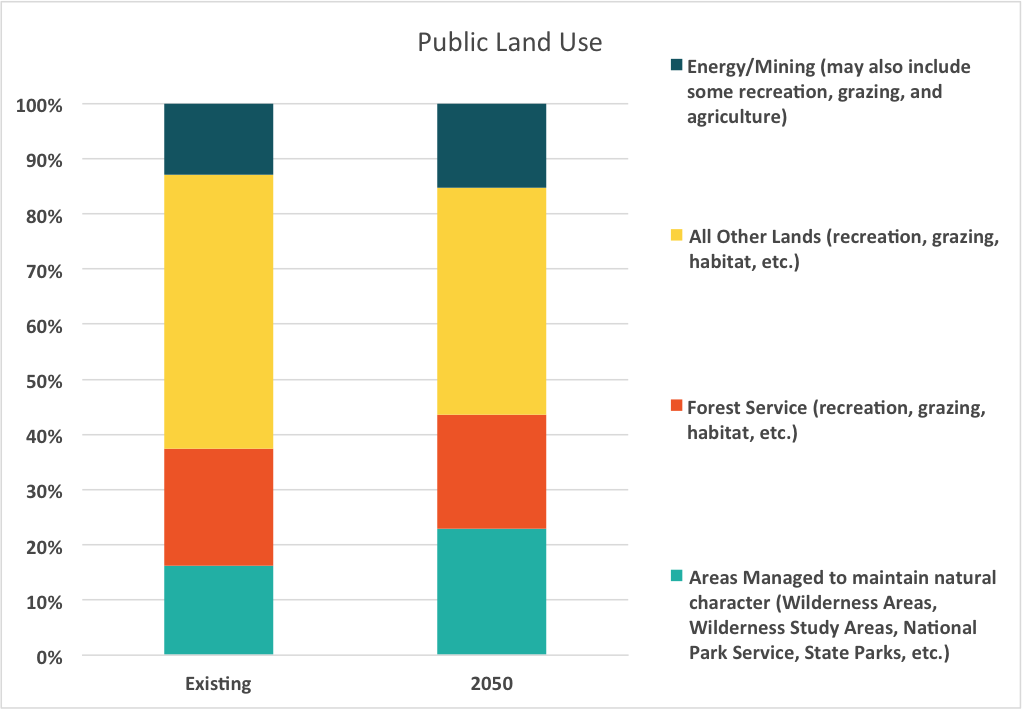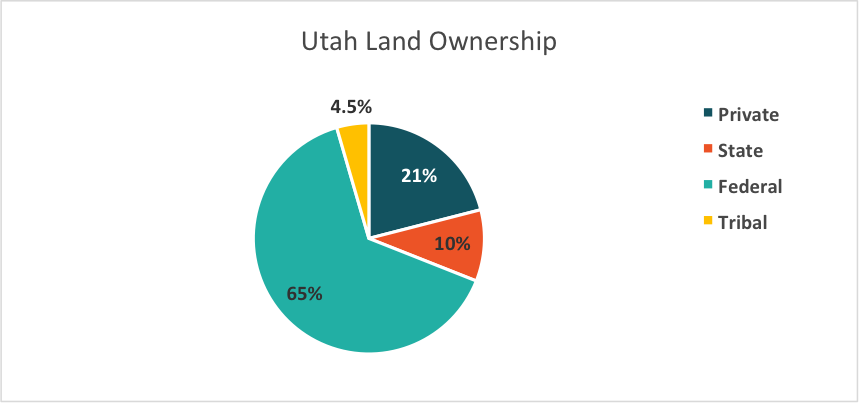The Story
Advocates for different uses of public lands compromise, and by 2050, Utah’s public lands are used for a balance of high-intensity and low-intensity purposes. While lands managed to preserve natural character expand, we also allow for more agriculture, mining, and recreation in some areas. Energy production increases in some areas, even as we prohibit some lands from being used for energy development. Additional lands designated for preservation are balanced by an increase in lands that allow high-impact recreation, like the use off-highway vehicles. As a result:
- Energy production (fossil fuels and renewables) and mining increase somewhat.
- Lands managed to preserve natural character (including wilderness) and low-impact recreation (hiking, fishing, etc.) increase somewhat.
- High-impact recreation (e.g., use of off-highway vehicles) increases somewhat.
- Grazing increases somewhat, and new rotational grazing techniques are explored to improve habitat and watershed functionality.
- Recreational facilities like trails and campgrounds expand to accommodate increased demand.

Results
In comparison to today, by 2050:
- Statewide jobs, economic development, and tax revenue increase.
- Rural Utah jobs, economic development, and tax revenue increase.
- Ecosystem health improves.
- The ability of watersheds to capture storm water for water supply and flood prevention is better.
- Our ability to meet our energy needs is greater.
- Our ability to meet our recreation needs is similar.
- Conflicts between increased numbers of recreational users and other users decrease.
Background
Utah is a spectacular place, known around the world for the beauty of its public lands. From deserts to alpine mountaintops, there’s a lot to love in Utah. However, there are competing uses for these lands, ranging from energy development to habitat preservation, and many of these demands are growing as our population, tourism, and need for outdoor recreation increase. How should we balance these demands? How these lands are managed has implications for ecosystem health, recreation, water supply, energy production, and Utah’s economy, particularly in the rural parts of the state.
Over 70% of Utah is public land owned by the federal or state government. Public lands include national forests, national and state parks, School and Institutional Trust Lands, and Bureau of Land Management (BLM) lands.
Bureau of Land Management (BLM)
About 42% of the public lands in Utah are managed by the Bureau of Land Management (BLM). These lands are managed for multiple uses, ranging from recreation and habitat preservation to grazing, energy, and mining.
National Forests
National forests in Utah constitute about 15% of Utah's public lands. The lumber industry in Utah declined and disappeared nearly two decades ago, and these areas are now mainly used for recreation and habitat. National forests are also used for limited amounts of mining, grazing, and energy development.
Wilderness and Parks
Approximately 11% of Utah's public lands are wilderness, wilderness study areas, state parks, and national parks and monuments. These areas are largely managed to preserve natural character and for recreational use. Though roads and bicycles are not permitted in wilderness and wilderness study areas, they are allowed in some locations in state and national parks.
School and Institutional Trust Lands
Almost 10% of Utah’s public lands are School and Institutional Trust Lands. When Utah became a state, Congress granted parcels of land to Utah from which revenue could be generated to support state institutions, including public schools, hospitals, teaching colleges, and universities. Today these lands generate revenue primarily for public schools.
Energy Development
Approximately 9% of Utah's public lands are leased for energy development, almost all for oil and gas, though much of this acreage is not being actively used to produce energy. Because oil and natural gas are found in only a few portions of Utah and most known reserves are already leased, there will likely be few additional oil and gas leases in the future. The largest concentration of oil and gas leases in the state is in the Uinta Basin, with other small areas scattered throughout the state. Public lands are also used to produce renewable energy like wind and solar power. As the state’s population grows and power generation shifts away from coal, Utah will likely need to produce more electricity from natural gas and renewables, like wind and solar, if we want to be energy self-sufficient.


Sources: Utah Automated Geographic Reference Center and BLM Utah: Oil and Gas


